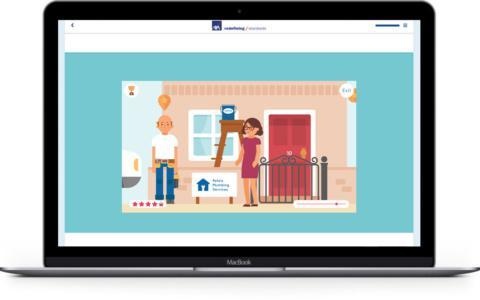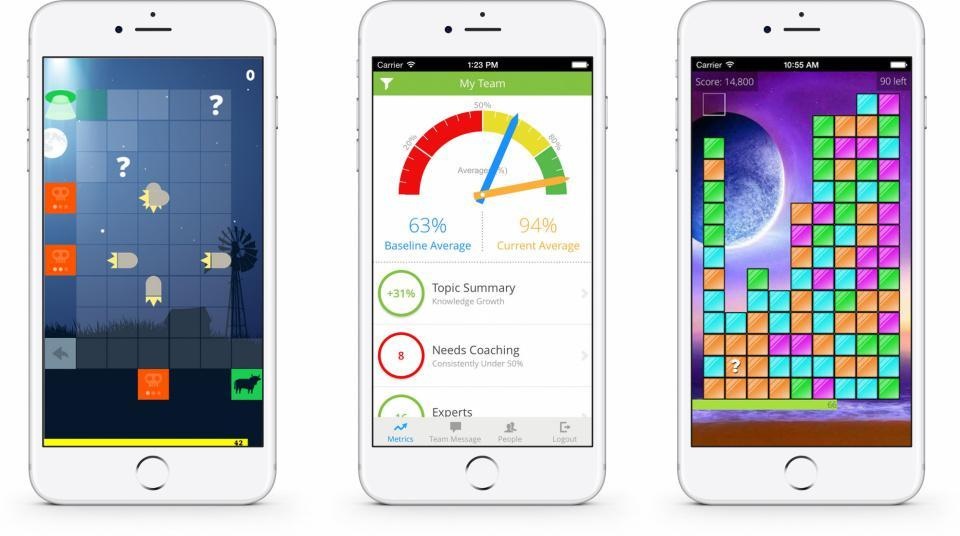A to Z of learning in 2017: 26 key insights

We’re waving goodbye to 2017 by looking at some of the key trends, developments, events and thinking in digital learning in the past 12 months.
And, we’ll also be looking ahead to 2018, when L&D will again be playing a key role in keeping organisations on top of all the momentous changes that are happening in the workplace.
So here goes, with 26 selected highlights. It’s our A-Z of learning in 2017:
A is for augmented reality
Augmented reality (AR) has a tremendous amount to offer as a performance support tool. By enabling computer-generated interactive enhancements to be layered on top of existing reality, AR is an exciting prospect for workplace learning. As pilot projects yield results, we’re expecting AR to gain further ground in 2018.
B is for blended learning
In 2017, we saw further evidence of how effective blended learning can be in transforming learning delivery. Some of the best examples of the industry were celebrated at the LT Awards in November, including our own gold-winning blend for AXA. Judges said: “A great example of the 'campaigns not courses' approach, with good mix of methods and tools used alongside a focus on how to transfer and embed this learning in an environment where it is both difficult to find time to learn and focus.”

C is for content conversion
Often misunderstood, content conversion isn’t simply about transferring legacy elearning to a new technology. It’s about intervening to release the value of your existing learning content. With the announcement in July 2017 that Adobe is finally turning Flash off in 2020, the issue of legacy elearning is becoming a pressing one for many learning teams.
D is for data protection
The General Data Protection Regulation (GDPR) kept L&D busy in 2017, with the need to prepare employees ahead of its introduction in May 2018. The latest research, suggest companies still have much to do, so expect GDPR to be a business priority early in 2018.
E is for experiential learning
Experiential learning theory may have been around for more than 30 years, but it has never been more relevant for organisations looking to invest in immersive learning technologies. Where the opportunity to learn by doing is not easy to come by or rehearse, digital experiential learning can offer the next best thing.
F is for focus on impact
When the learning is focused clearly on targeted results, the impact can be rapid and transformative. An example is the customer service learning at AXA, where, within nine months, positive customer comments were up by 113%, formal complaints were down by 24% and top-rated calls by insurance advisors rocketed by 114%.
G is for games
Learning games have impact by delivering immersive, memorable and experiential learning in a cost-effective way on PCs and devices. Their use will grow, as they use the technologies that are set to revolutionise the workplace and society: AR, VR, AI and 360° video.

H is for hard to reach
Deskless workers are often the public face of organisations, so they’re critical to a company’s success. However, they can be hard to reach with some not even having a work email address, let alone a desk. In December 2017, we stood up for deskless workers and argued that L&D needs to do more to reach them with the learning they need and deserve.
I is for intelligent learning
Artificial intelligence (AI) is what drives personalised, adaptable learning, and it is revolutionising training by enabling personalisation at scale. With AI, practice might well make perfect by creating better, quicker learning that’s more relevant to each learner.
J is for journeys
Learning isn’t just about the destination, it’s about the journey, too. The journey should be based on the learning requirements and it is this that will dictate the types of media used as well as the structure and flow.
K is for knowledge
How much your employees know and remember can have a profound impact on their ability to perform well at work. In 2017, we’ve been helping organisations to close the employee knowledge gap with Axonify, a training platform that combines modern technology with proven brain science to grow employee knowledge every day.
L is for learning curation
There’s so much information freely available online, but the task is to make sure learners are accessing the correct content. Curation utilises internal and external content and brings together knowledge about topics, that learners can access when needed.
M is for microlearning
Using proven brain science, a microlearning platform sends out small chunks of relevant, personalised learning repeatedly until the learner ‘gets it’ and can move on to the next phase. It’s built for the modern worker and modern workplace, delivered on demand, without work disruption, on devices or PCs.

N is for new generation
By 2025, it’s estimated that 75% of the workforce will be Millennials. What’s more, this key generation will increasingly take the spotlight in 2018 as they move into senior management roles. Hot on their heels, are Generation Z, the first fully ‘digitally native’ generation. Meeting their needs and expectations will become increasingly important in workplace learning.
O is for onboarding
Getting onboarding right gets new employees involved, confident and contributing ASAP. Onboarding should be inspiring, not a ‘tick box exercise’ – and it should be the starting point for continuous learning, where the new hires can see their development and progress.
P is for personalisation
This makes learning as relevant as possible to each learner – and L&D have an important role to play at the ‘benchmark stage’. Personalisation takes into account all aspects of the employee’s role and knowledge and leads to adaptive learning, where learning journeys respond according to progress.
Q is for questions
Daily questions, to be precise, fired out to employees for three to five minutes each day to reinforce learning. Delivered via a microlearning platform, usually in a game or quiz, it’s intelligent enough to plug learning gaps, ultimately achieving behaviour change.
R is for reinforcement
Using the principles of retrieval and spacing, reinforcement is what helps us to retain knowledge. In workplace learning, this bite-sized method is particularly effective in goal or task-orientated learning situations.
S is for science
Whether it’s microlearning, reinforcement, analytics, AR, VR, AI or robotics, modern learning is based on science and what we know about how the brain works. These Fourth Industrial Revolution learning methods will dominate workplace learning and will be joined by other science-driven learning, such as haptics.
T is for transformation
Digital transformation is one of the top five business challenges in 2018, as organisations grapple with the scale and pace of change. How well employees respond and adapt to change will, in part, depend on whether L&D provides the learning and support required for a successful transition.
U is for user experience
Employees want learning that uses the same technologies they use outside of work, hence the move towards devices and immersive learning. L&D should listen to what the learners are saying, because user experience is essential for an effective learning experience.
V is for virtual reality
Our own research has added to the growing evidence that VR is more memorable and effective than traditional learning, increasing knowledge acquisition and retention. This isn’t surprising, given that VR is engaging and experiential, allowing participants to ‘try out’ the learning in a safe environment.

W is for workplace shift
The current volume of change in the workplace has no precedent, to the extent that we’re having to prepare for jobs that don’t exist yet, while other skills won’t be needed. It means L&D and company boards must take a longer-term view on training needs to ensure their organisation has the correct skill sets to progress.
X is for iPhone X
The iPhone X was announced in September 2017. It represents a decade of smart phone development since the original iPhone release. Just like the original, the iPhone X is likely to influence other device manufacturers to advance sensor and camera technology that will, in turn, enable the next wave of AR and it's learning potential.

Y is for YouTube
YouTube has become the training resource of choice for anyone looking to solve a problem or learn a skill. Existing external content can be used as part of curation, while organisations can use the platform for their own bespoke content, perhaps as part of blended learning.
Z is for zzz
There’s no longer any excuse for dull training that sends people to sleep! Learning should be creative and personalised, with the focus on user experience while also meeting business needs. Technology allows this type of person-centric learning to be rolled out to individuals and to scale. And it works.
So what does 2018 hold in store for L&D and business? Some pretty big challenges for a start – challenges such as boosting productivity; upskilling or re-skilling workers; ensuring the organisation is fit for purpose in the digital era; and, of course, GDPR. L&D’s focus is on training that has an impact on the bottom line. Learning technologies, more than ever, are focused on business goals and they reflect modern working. In 2018, successful L&D teams will step up to ensure their firms take action to solve the challenges.